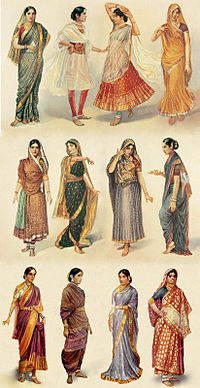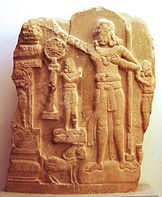- Clothing in India
-
The traditional clothing in India varies with region, religion and community. The formal business attire is fairly uniform across the country, and similar to the western clothing.
Contents
Women's Clothing
 Illustration of different styles of Sari & clothing worn by women in South Asia
Illustration of different styles of Sari & clothing worn by women in South Asia
Women's clothing in India varies widely and is closely related to local culture, religion and climate.
Traditional Indian clothing for women are the saris or the salwar kameez and also gaghra cholis (lehengas). Saris made out of silk are considered the most elegant. Mumbai, formerly known as Bombay, is one of India's fashion capitals. In some village parts of India, traditional clothing is worn. Women wear a sari, a long sheet of colorful cloth with patterns. This is draped over a simple or fancy blouse. This is worn by young ladies and women. Little girls wear a pavada. Both are often patterned. Bindi is part of the women's make-up. Indo-western clothing is the fusion of Western and Subcontinental fashion. Churidar, dupatta, Khara Dupatta, gamchha, kurta, mundum neriyathum, sherwani are among other clothes.
The traditional style of clothing in India varies with male or female distinctions. This is still followed in the rural areas, though is changing in the urban areas. Girls before puberty wear a long skirt (called langa/paawada in Andhra) and a short blouse, called a choli, on top of it. Teenage girls wear half-sarees, a three piece set consisting of a langa, a choli and a stole wrapped over it like a saree. Women usually wear full sarees.
A saree or sari is a female garment in the Indian subcontinent.[1] A sari is a strip of unstitched cloth, ranging from four to nine metres in length that is draped over the body in various styles. There are various traditional style of Sharee like Sambalpuri Saree from East, Kanchipuram from south, Paithani from West and Banarasi from North. The most common style is for the sari to be wrapped around the waist, with one end then draped over the shoulder baring the midriff.[1] The sari is usually worn over a petticoat (ghagra has short sleeves and a low neck and is usually cropped, and as such is particularly well-suited for wear in the sultry South Asian summers). Cholis may be "backless" or of a halter neck style. These are usually more dressy with a lot of embellishments such as mirrors or embroidery and may be worn on special occasions. Women in the armed forces, when wearing a sari uniform, don a half-sleeve shirt tucked in at the waist.
The shalwar kameez is the most popular traditional dress for females. It consists of loose trousers (the shalwar) topped by a long loose shirt (the kameez). It is often mispronounced as "punjabi suit" or simply "shalwar" / "churidaar" in Southern India. It was introduced by the Muslims and originates from the Islamic era or old Iranian culture. It is very common in Pakistan and Afghanistan. It is always worn with a scarf called a dupatta, which is used to cover the head and drawn over the busom. This dress is worn by almost every teenage girl in lieu of western clothes. The salwar kameez is most common in the northwestern part of India. Many actresses wear the Shalwar Kameez in Bollywood movies.
The women of Rajasthan and Gujarat often wear colorful swirling skirts called lehenga, paired with a short bodice called a choli. If they must cover their heads, they do so with bright veils called odhani. Popular among unmarried women other than salwar kameez are Gagra choli and Langa oni.
Men's Clothing
A Chakravati wears a pancha in an ancient style. First century BCE/CE. Amaravati, Andhra Pradesh. Musee GuimetFor men, traditional clothes are the kurta. In south India men wear long, white sheets of cloth. In north Indian languages like Hindi, Marathi and Oriya these are called dhoti, while in Tamil they are called veshti. Over the dhoti, men wear shirts, t-shirts, or anything else.
The bridal party in Indian cultures is often dressed more formally than guests. Although some men are choosing to wear a more traditional “western” three piece suit, they often save this for a reception. Just as the bride’ Indian Wedding Dress is unique and special, so too should be the groom’s attire.
A Sherwani is a long coat-boss jacket fastened with buttons. It comes to just below the knees, hitting somewhere high on the calf. The jacket has a Nehru collar, which is a collar that stands up.
This jacket is often cream, light ivory, or gold colored for weddings, especially those in the morning. It can be embroidered with gold or silver. While traditionally light in color, the jackets can be worn in dark colors, like reds, blacks, or navy, typically later in the day. A scarf is sometimes added to the jacket over one or both shoulders.
The Sherwani is worn with tighter fitting pants or trousers called churidars. Churidars are trousers that are loose around the hips and thighs, but are tight and gathered around the ankle.
Modern fashion in India
Aspects of Western fashion have become common among Indian men, particularly in the professional community. Horizontal stripes and plaids are common on casual business shirts, particularly among Indians in North America. Owing to growth of women empowerment and influence of western culture, nowadays most of the teen and adult girls in cities wear low hip jeans, low neck tops, tight jean trousers with salwar, half trousers, sleeveless T shirts etc. Women who hail from rural villages usually wear frocks and half sarees; boys normally wear a shirt and pants, whether formally or casually.
Accepted formal dressing for couples in formal occasions like parties and weddings is saree for the ladies and formal pants and shirts with suits in the winter for the men. While one is utterly ethnic and Indian the latter is very western and out of India.
The Indian women have however modernized and working women find Western Wear like shirts and trousers a comfortable dressing option to work. With entry of international fashion brands like FCUK, DKNY, Guess and many more, Indian women are increasingly becoming fashionable (in terms of Western standards). Among the league of high fashion international brands, domestic brands like Globus, BlackBerry's, Allen Solly, Park Avenue and Van Heusen, have also gained popularity. India has a lot of well known popular fashion designers like Ritu Kumar, Suneet Varma, Sabyasachi Mukherjee and Tarun Tahiliani
Indian Tattoo
Indian Mehndi or Tattoo is the most famous design since it is a big dot or figure in the middle of the palm, with finger tips colored completely. It also includes Arabic Tattoo whereby this style tend to be less detailed and intricate. It still very beautiful. Instead of having fill-ins it is just colored in boldly. Arab designs do not necessarily cover your hands or feet all the way. Many popular Arabic designs are vines and leaves with beautiful flowers. This makes it an excellent and perfect candidate, if you want to have a bail going down your arm or leg.
Gallery
-
Woman wearing a churidar and kameez
-
Girls wearing Gagra choli
See also
- Kurta
- Patiala salwar
- Wedding sari
- Khara Dupatta
References
Further reading
- Boroian, Michael; Poix, Alix de. (2008). India by Design: The Pursuit of Luxury and Fashion. ISBN 0470823968.
- Russell, Rebecca Ross (2010). Ownership Case Study: Indian Wife/Widow Jewelry, in: Gender and Jewelry: A Feminist Analysis. CreateSpace. ISBN 1452882533.
Clothing in South Asia Clothes Achkan • Ajrak • Bakhu • Blouse • Burqa • Choli • Churidar • Dhoti • Dupatta • Farshi Pajama • Gagra choli • Ghoonghat • Gamchha • Gamosa • Gharara • Gho • Jamavar • Jodhpuri • Jubba • Kabney • Kasta sari • Kaupina • Khalat • Kira • Kota doria • Kurta • Lehenga Style Saree • Langa oni • Langota • Lungi • Madisar • Mekhela chador • Mufti • Mundu • Mundum Neriyathum • Naga shawl • Nehru jacket • Onnara • Patiala salwar • Riha • Sari • Salwar kameez • Sambalpuri Saree • Sarong • Set-saree • Sherwani • Toego • Uttariya • WonjuHeadgear Stitching/designing Categories:- Indian culture
- Indian clothing
- History of Asian clothing
Wikimedia Foundation. 2010.









